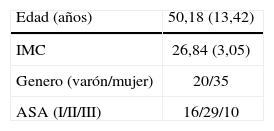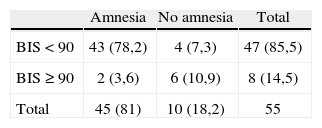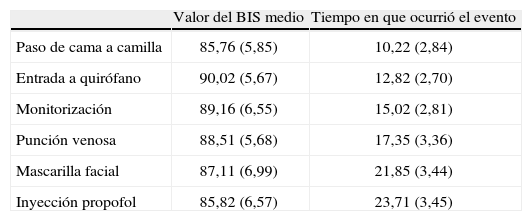Determinar la capacidad del índice biespec-tral (BIS) como predictor de amnesia anterógrada para los eventos que ocurren desde la llegada a quirófano de los pacientes hasta la inducción anestésica, después de preme-dicarlos con 10mg de midazolam intranasal.
Pacientes y métodosPacientes intervenidos para cualquier intervención quirúrgica programada con anestesia general, después de monitorizarlos con el índice bies-pectral y administrarles 10mg de midazolam por vía intranasal. Se observó el BIS hasta que empezó a bajar de manera continua y mantenida por debajo del valor de 90, se anotó el tiempo transcurrido y se les trasladó a quirófano. Todos los pacientes fueron sometidos a seis maniobras rutinarias antes de la inducción. Finalizada la intervención se les interrogó sobre los recuerdos de las maniobras realizadas. Se estudiaron los valores de sensibilidad, especificidad y valores predictivos; para obtener la cifra de BIS que presenta una mejor combinación de sensibilidad y especificidad, se trazó una curva ROC.
ResultadosIncluímos 55 pacientes, el tiempo medio transcurrido en descender el valor de BIS fue 5,93±2,93minutos. La sensibilidad total de la prueba es de 0,96 y la especificidad de 0,60, el valor predictivo positivo de 0,91 y el valor predictivo negativo de 0,75. El valor global de la prueba es del 89,1%. El mejor valor de corte de la curva ROC es 83.
ConclusionesLa disminución del BIS por debajo del valor de 90 se puede usar como predictor de amnesia anterógrada tras la administración de 10mg de midazolam intranasal.
To determine the ability of the bispectral index (BIS) to predict anterograde amnesia for events occurring between the arrival of patients in the operating theater and anesthetic induction, following premedication with 10mg of intranasal midazolam.
Patients and methodsWe enrolled patients scheduled for any type of surgery under general anesthesia. Patients were first monitored using the BIS and administered 10mg of intranasal midazolam. The BIS was monitored until it began to fall steadily and remained below a value of 90; the elapsed time was recorded and the patient was taken to the theater. All patients underwent 6 routine maneuvers before induction. After surgery, patients were asked about their memory of the maneuvers performed. Sensitivity, specificity, and predictive values were studied to obtain the BIS value that provided the best combination of sensitivity and specificity, and a receiver operating characteristic (ROC) curve was drawn.
ResultsWe enrolled 55 patients. The mean (SD) time taken for the BIS value to fall was 5.93 (2.93)minutes. The sensitivity of the test was 0.96 and specificity was 0.60. The positive predictive value was 0.91 and the negative predictive value was 0.75. The test classified 89.1% of the patients correctly. The ROC curve showed the best cutoff to be 83.
ConclusionsA fall in the BIS to below 90 can be used as a predictor for anterograde amnesia following administration of 10mg of intranasal midazolam.
Artículo
Comprando el artículo el PDF del mismo podrá ser descargado
Precio 19,34 €
Comprar ahora












